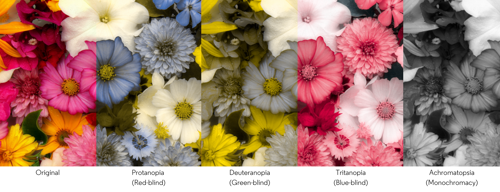Colour Vision Deficiency (CVD), commonly known as colour blindness, is a condition that alters how people perceive colours. Affecting approximately 4.5% of the UK population, it's a condition experienced by many. This blog marks Colour Blindness Awareness Day (6th September) and explores the complexities of living with Colour Vision Deficiency.
What is colour blindness?
Colour blindness hinders a person's ability to differentiate between specific colours. It arises from impaired function of the eye's cone cells, the light-sensitive cells responsible for colour vision. These cells convert light into neural signals, interpreted by the brain as colour.
The most common is deutan and protan (red-green) colour blindness, where the sensitivity of green and red cone cells overlaps, making it difficult to distinguish these hues. Other forms include tritanopia (blue-yellow), and achromatopsia (black-white) – all with their own colour adaptations.

To indicate the severity of the condition, it will typically be divided into four categories: slight, moderate, strong and absolute.
Who does colour blindness affect?
Colour Vision Deficiency is more prevalent in men than women. Additionally, certain factors can increase your risk of developing this condition:
- Family history: Having relatives with colour blindness increases your likelihood of inheriting the condition.
- Eye diseases: Certain eye conditions can affect colour vision. For example, glaucoma, macular degeneration and cataracts.
- Health conditions: Diabetes, Alzheimer's disease and multiple sclerosis are associated with an increased risk.
- Medications: Some medications can impact colour perception.
How does colour blindness affect daily life?
While colour blindness doesn't prevent someone from living a full life, it can create obstacles. Everyday tasks like reading traffic signals, using technology and identifying objects become more complex. Even simple choices like decorating or picking out clothes can be challenging.
How do we test for colour blindness?
Colour Vision Deficiency is diagnosed through various tests administered by eye care professionals. The most common test for red-green colour blindness is the Ishihara test. This involves identifying numbers or shapes hidden within patterns of coloured dots. Some patterns are designed to be visible only to those with normal colour vision, while others reveal details to individuals with colour vision deficiencies.
How do you book an eye test for colour blindness?
Based on the Ishihara test results, your eye care provider may recommend additional tests to confirm the diagnosis and gather more information. Colour vision tests are not part of our usual eye exams, so please make sure you let us know if you would like one when booking your eye test.
How does colour blindness affect children?
Because many people with Colour Vision Deficiency have no reference point for normal colour vision, they may be unaware of their condition throughout their life. This is why early detection through comprehensive eye examinations, ideally prior to starting school, can be crucial to learning development and overall eye health. Many educational tools rely on colour to communicate information and measure student progress - early diagnosis can make a world of difference.
Signs your child may be experiencing CVD:
- Shows little interest in colouring activities
- Struggles to sort or identify colours correctly
- Uses unexpected or incorrect colours when painting or drawing
- Frequently smells food before eating it
Living with Colour Vision Deficiency
While there is no permanent solution for colour vision deficiency, those affected must seek a diagnosis to understand their specific condition and learn effective coping strategies to navigate the world effectively.
At Optical Express, our optometrists are highly qualified to diagnose and advise those with the condition. If you suspect that you or someone in your care may be experiencing colour blindness, don’t hesitate to schedule an appointment with one of our eye care professionals.
Book an eye test